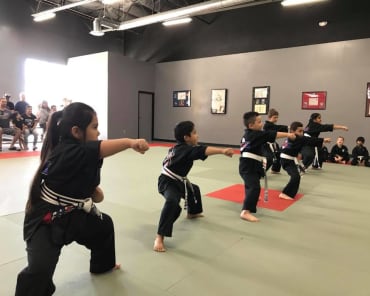
𝐌𝐲 𝟏𝟐 𝐑𝐮𝐥𝐞𝐬 𝐟𝐨𝐫 𝐓𝐫𝐚𝐢𝐧𝐢𝐧𝐠
It is my belief that in order to be a quality martial arts teacher, I ought to be continuing with my training. So over the years, I have developed a series of training rules that have proven effective in my development and my longevity. It started out as more of an unconscious thing, but as time goes by, I’ve become more mindfully aware of these rules. The reality is, when I put these rules into practice, good stuff happens. Perhaps you will find them valuable for your training as well.
1) 𝐄𝐦𝐩𝐭𝐲 𝐲𝐨𝐮𝐫 𝐜𝐮𝐩 - Most martial arts schools have a practice of bowing onto the mat before training and bowing off the mat after training. There might be several reasons why this is practiced, but for me, the most important reason is it gives me a chance to empty my cup. Making this a ritual before every training can really aid in practice.
2) 𝐁𝐞 𝐏𝐫𝐞𝐬𝐞𝐧𝐭 𝐟𝐨𝐜𝐮𝐬𝐞𝐝 - The second step follows the first step nicely. It’s natural to be distracted during class. Our mind can wander to what happened at work today or what we are going to eat for dinner tonight. The more we can become aware of our distractions, the sooner we can overcome them. As it was once said “ The secret of true concentration lies in the acceptance of endless distractions”. When you find yourself distracted, simply re-focus on the task at hand. Over time, your focus will improve dramatically.
3) 𝐃𝐨𝐧’𝐭 𝐜𝐨𝐦𝐩𝐚𝐫𝐞 - It’s natural for us to compare ourselves with other people that we share the mat with. Sometimes when we compare we might look really good, other times not as much. It really depends on who we compare ourselves to. The challenge is, comparisons are never fair. Everyone is running their own race. Sometimes I find myself comparing myself to a younger version of me. This is not fair either. The best thing that we can do is focus on giving our best.
4) 𝐁𝐞 𝐭𝐡𝐨𝐫𝐨𝐮𝐠𝐡 𝐰𝐢𝐭𝐡 𝐲𝐨𝐮𝐫 𝐰𝐚𝐫𝐦-𝐮𝐩 - As I mature and age, this rule is becoming more important than ever. Beginning training with a good warm-up is a great habit for people of all ages, but it’s really a necessity for older Martial artists. Nearly every injury that I have sustained in the last decade has been due to a lack of warm-up.
5) 𝐅𝐨𝐜𝐮𝐬 𝐨𝐧 𝐨𝐧𝐞 𝐝𝐞𝐭𝐚𝐢𝐥 𝐚𝐭 𝐚 𝐭𝐢𝐦𝐞 - I don’t know about you, but I’ve got a lot of room for improvement. If I tried to fix all of my flaws at the same time, I would get nowhere. I have found a better approach is to focus on one detail at a time. It’s the exact same thing that I would do with the student,. Once I feel like I’ve made more progress, I might focus on another detail. A great question to ask yourself while training is “what am I learning?”
6) 𝐕𝐢𝐬𝐮𝐚𝐥𝐢𝐳𝐞 𝐭𝐡𝐞 𝐚𝐩𝐩𝐥𝐢𝐜𝐚𝐭𝐢𝐨𝐧 - Is it real. Once you have a movement down well, I believe it’s important to imagine the situation where you might apply it. It might on the mat, in a ring, in a cage or in a back alley. Remember, the more vivid you can make it, the better prepared you will be.
7) 𝐄𝐦𝐛𝐫𝐚𝐜𝐞 𝐟𝐚𝐭𝐢𝐠𝐮𝐞 - As of Vince Lombardi once said “poor endurance makes cowards of us all”. Not only does training fatigued help us to become better conditioned, but possibly more importantly, it gets us comfortable being uncomfortable. Chances are very good that if we ever have to defend ourselves, we will be fatigued. And if we’ve been there before, it will be easier for us to call upon the courage and tenacity that it’s going to take to overcome. Just remember that when training fatigued, make sure not to overdo it. Pick safe drills where the risk of injury is minimized.
8) 𝐁𝐞 𝐜𝐨𝐧𝐬𝐢𝐬𝐭𝐞𝐧𝐭 - This is an often neglected rule. It is been my experience that you will not find an active Martial artist over 50 that is not consistent. Inconsistency leads to injury. As my dad always said, “a little of something is better than a lot of nothing“. Try to get some training in every day
9) 𝐓𝐫𝐚𝐢𝐧 𝐬𝐚𝐟𝐞 - Listen to your body. As I mentioned earlier, training while fatigued is important, however it also can lead to injury. That’s why it’s so important to pick your techniques and partners wisely and make sure that what you’re doing is age-appropriate and skill appropriate.
10) 𝐓𝐨 𝐁𝐞 𝐅𝐚𝐬𝐭...𝐆𝐨 𝐬𝐥𝐨𝐰 - Over the years, in my hurry to do a movement quickly, I have glossed over some details to only later have to go back and re-learn something. It is been my experience that relearning something is a lot harder than learning it right the first time. That’s why I try to focus on going slow and being smooth until I get a movement down really well, then I gradually pick up speed. The result is that you develop less bad habits and more efficient movement, which leads to greater speed and power
11) 𝐒𝐭𝐚𝐲 𝐏𝐥𝐚𝐲𝐟𝐮𝐥 - Keep it fun. Everyone started training for different reasons, but what keeps people coming back decade after decade is not self-defense or fitness it’s enjoyment. I find it really valuable to create environment that makes it easier to have fun. Do the right drill, pick the right partner, whatever it takes to keep the process fun.
12) 𝐂𝐨𝐧𝐬𝐭𝐚𝐧𝐭𝐥𝐲 𝐫𝐞𝐯𝐢𝐞𝐰 𝐚𝐧𝐝 𝐞𝐯𝐚𝐥𝐮𝐚𝐭𝐞 - Have you ever had to relearn the same technique several times because you didn’t practice in between sessions? I thought so. Me too. It has been my experience that if I take time at the end of a training session to think about what I’ve learned and perhaps even review it then I retain it much better. This seems obvious now, but it took me decades to figure out.





